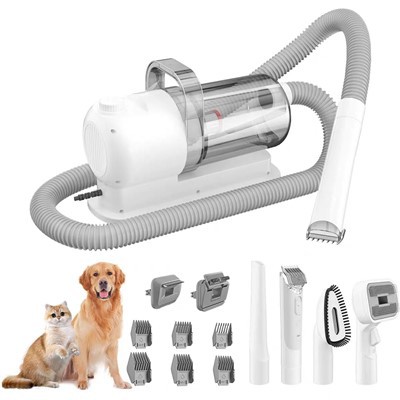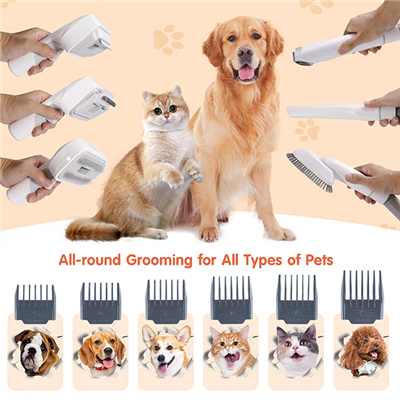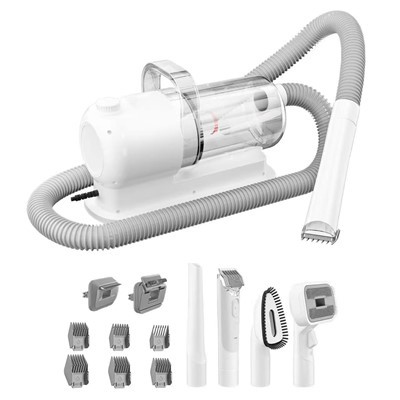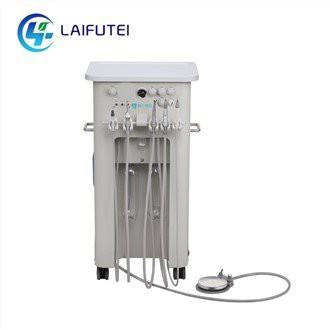Veterinary dental cleaning, also known as a dental prophylaxis, is a procedure performed by a veterinarian or a specialized veterinary dentist under general anesthesia. The primary purpose of this procedure is to remove plaque and tartar from the teeth and to evaluate the overall oral health of the pet.
Removal of Plaque and Tartar
Plaque and tartar are common in pets, especially those that do not receive regular dental care. These substances can harbor bacteria that can lead to gum disease and tooth decay. During a dental cleaning, veterinary professionals use specialized tools to remove plaque and tartar from the teeth, effectively reducing the risk of these bacterial infections.
Improved Oral Hygiene
Regular dental cleanings help maintain good oral hygiene in pets. By removing plaque and tartar, the risk of gum disease and tooth decay is significantly reduced. This not only improves the pet's oral health but also contributes to their overall well-being, as poor oral hygiene can lead to other health issues.
Early Detection of Oral Health Issues
During a dental cleaning, veterinary professionals perform a thorough oral examination. This allows them to detect any signs of oral health issues, such as broken teeth, tumors, or abnormal wear. Early detection and treatment of these issues can help prevent further complications and improve the pet's quality of life.
Reduced Risk of Systemic Disease
Poor oral health can have a significant impact on a pet's overall health, as bacteria from the mouth can enter the bloodstream and cause systemic disease. Regular dental cleanings help reduce the risk of systemic diseases by maintaining good oral health and preventing bacterial infections.
Enhanced Quality of Life
Pets with poor oral health often experience discomfort and pain when eating or playing. Regular dental cleanings help alleviate these symptoms by improving oral health and reducing the risk of dental disease. This enhanced quality of life allows pets to enjoy their favorite activities and spend more quality time with their owners.
Why Choose Us
Competitive Prices
We offer our products at competitive prices, making them affordable for our customers. We believe that high-quality products should not come at a premium, and we strive to make our products accessible to all.
Efficient And Convenient
The company has established marketing networks around the world to provide high-quality services to customers in an efficient and convenient manner.
Advanced equipment
We take great measures to ensure that we work with the industry’s highest quality equipment and that our equipment is regularly and meticulously maintained.
High quality products
We always put customer needs and expectations in the first place, refine on, continuous improvement, to seek every opportunity to do better, to provide customers with their expectations of quality products, to provide customers with the most satisfactory service at anytime.
Rich Experience
Has a long-standing reputation in the industry, which makes it stand out from its competitors. With over many years of experience, they have developed the skills necessary to meet their clients' needs.
Professional team
We have a team of skilled and experienced professionals who are well-versed in the latest technology and industry standards. Our team is dedicated to ensuring that our customers get the best service and support possible.
Scaling and Polishing
This is the most common type of veterinary dental cleaning. It involves removing tartar and plaque from the teeth using special tools such as scalers and polishers. This procedure helps to prevent gum disease and tooth decay.
Dental Prophylaxis
This type of cleaning is similar to scaling and polishing but is more comprehensive. It includes a thorough examination of the teeth and gums, as well as cleaning and polishing the teeth. Dental prophylaxis may also include fluoride treatment to strengthen the teeth.
Root Planing
This procedure is used to treat advanced gum disease. It involves smoothing the roots of the teeth to remove bacteria and tartar that have accumulated below the gum line. Root planing can help to prevent tooth loss and improve the overall health of the gums.
Crown and Bridge Preparation
This type of cleaning is done before placing a crown or bridge. It involves removing any decay or damaged tooth structure and preparing the teeth for the placement of the restoration. Crown and bridge preparation helps to ensure a proper fit and long-lasting restoration.
Extraction
In some cases, teeth may need to be extracted due to severe decay or periodontal disease. Extracting teeth can help to relieve pain and prevent further infection. After extraction, the socket may be cleaned and sutured to promote healing.
How Often Should My Pet Receive a Dental Cleaning

Puppies and kittens
Puppies and kittens should receive their first dental cleaning when they are around 6 months old. This helps to establish good oral hygiene habits from a young age and prevent the development of dental problems later on.

Adult pets
Most adult pets should receive a dental cleaning every 1-2 years. This helps to remove tartar and plaque that can accumulate on the teeth and prevent the development of gum disease and tooth decay.

Senior pets
Senior pets may require more frequent dental cleanings due to age-related changes in the mouth. Pets over 7 years old may benefit from annual or semi-annual cleanings to maintain good oral health.

Pets with existing dental problems
Pets with existing dental problems, such as gum disease or tooth decay, may need more frequent cleanings to manage their condition. Your veterinarian may recommend cleaning every 3-6 months or as needed.
Depending on the pet's behavior and the complexity of the procedure, the animal may be sedated or placed under general anesthesia. Sedation or anesthesia are essential to ensure the safety of both the pet and the dental team, as well as to allow for a thorough and effective cleaning.Once the pet is sedated or anesthetized, the dentist or technician performs a thorough oral examination. This includes checking the teeth for decay, fractures, or abnormal wear patterns, as well as examining the gums for any signs of inflammation, recession, or infection.
Scaling involves the removal of tartar and plaque from the teeth using special instruments. This is followed by polishing, which uses a toothpaste and brush to smooth the tooth surface and remove any remaining plaque. Scaling and polishing help restore the teeth to their original condition and prevent future tartar buildup. Fluoride treatment is often recommended to help strengthen the teeth and prevent future decay. A fluoride varnish or gel is applied to the teeth, which is then allowed to sit for a few minutes before being rinsed off.
If any teeth are found to be severely damaged or infected, they may be extracted during the procedure. This is done using surgical instruments under sterile conditions to minimize the risk of infection. Once the cleaning is complete, the dentist or technician performs a final examination to ensure that all tartar and plaque have been removed, and that the teeth and gums look healthy.
If the pet was sedated or anesthetized, they will need to recover from the effects of the medication. This usually involves monitoring the pet's vital signs and ensuring they are stable before being released to go home. After the procedure, the veterinarian may recommend follow-up care, such as a specific diet or regular brushing, to maintain the pet's oral health. They may also schedule regular dental check-ups to monitor for any future dental issues.
What Are the Signs That My Pet May Need a Dental Cleaning
Persistent bad breath is often one of the first indicators of dental problems. While some degree of doggy or kitty breath is normal, strong odors can signify the presence of bacteria in the mouth due to plaque and tartar buildup.A yellowish or brownish discoloration on the teeth is usually due to tartar, which forms when plaque hardens. This indicates that a professional dental cleaning is necessary to remove these deposits. Inflamed gums, known as gingivitis, are a sign of gum disease. Healthy gums should be pink and firm; redness and swelling can indicate infection. If you notice blood when your pet eats or when you brush their teeth, it could be a sign of gum disease or another dental issue. Pets with dental pain may have trouble chewing or may avoid certain foods, especially dry kibble or hard treats. As dental disease progresses, teeth can become loose or even fall out. This is a clear indication that a dental cleaning is needed and that there may be underlying health issues. Constant pawing or rubbing at the face or mouth can indicate oral discomfort. Dental pain can lead to changes in behavior, including irritability, depression, or lethargy. Some pets may become more vocal, whining or yelping when they eat or have their mouth touched.
Is My Pet Sedated During the Dental Cleaning
Most pets are sedated or anesthetized during veterinary dental cleanings to ensure their comfort and safety during the procedure. A sedative or anesthetic can help your pet stay relaxed and prevent any pain or discomfort during the cleaning process. The type and amount of sedative or anesthetic depends on your pet's size, age, health, and personal needs. Your veterinarian will develop an appropriate sedation or anesthesia plan for your pet based on these factors.
While under sedation or anesthesia, your pet will be closely monitored by a team of veterinary professionals, including veterinarians and technicians. They will monitor your pet’s vital signs, such as heart rate, respiratory rate, and blood pressure, to ensure his or her safety throughout the entire procedure.
Once cleaning is complete, your pet will be monitored until they have fully recovered from their sedation or anesthesia. You may be asked to observe your pet at home for the next 24 hours to make sure they are eating and behaving normally.Sedation and anesthesia carry some risks, although these risks are usually very low. Your veterinarian will discuss these risks with you before surgery and take all necessary precautions to ensure your pet's safety. If you have any questions about sedation or anesthesia, discuss them with your veterinarian.
Your pet will be sedated or anesthetized to ensure their comfort during the procedure. A full physical examination will be performed to ensure your pet is healthy enough for the cleaning. Your veterinarian will use special tools to remove tartar and plaque from the teeth. This process is called scaling and helps to prevent gum disease and tooth decay. After scaling, the teeth will be polished to remove any remaining plaque and stains. This helps to leave the teeth smooth and shiny. Your veterinarian may take X-rays of your pet's teeth to check for any underlying problems such as tooth abscesses or root canal infections. Your veterinarian will perform a thorough examination of your pet's teeth and gums to check for any signs of disease or damage. They may also check for any loose or broken teeth. A fluoride treatment may be applied to the teeth to help strengthen them and prevent tooth decay. Your veterinarian will provide you with instructions on how to maintain your pet's oral health after the cleaning. This may include recommendations for a specific diet, toothbrushing, and regular dental check-ups.

Monitoring Recovery
After sedation, it's important to monitor your pet's recovery closely. Expect them to be groggy or sleepy for a few hours, depending on the sedative used.
Make sure your pet has a quiet, safe place to rest and avoid any stressful situations.
Monitor their behavior, heart rate, respiratory rate, and any other symptoms that may indicate discomfort or discomfort.
Feeding and Water
Once your pet is fully awake and alert, they should be able to eat and drink normally.
Provide soft food or wet food for the first meal after sedation to avoid any discomfort in chewing.
Ensure your pet has access to fresh, clean water at all times.
Oral Care Instructions
Your veterinarian may provide you with instructions on how to care for your pet's oral health at home.
Regular brushing of your pet's teeth is crucial to prevent tartar build-up and dental issues. Use pet-specific toothpaste and a small, soft-bristled toothbrush.
Schedule regular dental check-ups with your veterinarian to monitor your pet's oral health.
Medication
If prescribed, make sure to give your pet any medication as directed by your veterinarian.
Monitor for any side effects or reactions to the medication and contact your veterinarian if any concerns arise.
Scheduling Future Appointments
Schedule a follow-up appointment with your veterinarian if recommended. This will allow the veterinarian to check on your pet's recovery and oral health status.
Watching for Signs of Complications
Keep an eye out for any signs of complications, such as excessive bleeding, swelling, or pain.
If your pet exhibits any unusual symptoms or behavior, contact your veterinarian immediately.
How Long Does a Veterinary Dental Cleaning Take
Before the actual cleaning begins, there is preparation time for setting up the equipment, reviewing the pet's medical history, performing a pre-anesthetic evaluation, and administering anesthesia. This phase can take about 15 to 30 minutes, but the exact time can vary based on the pet's response to the anesthesia and how quickly they are ready for the procedure.
Once the pet is sedated and stable, the veterinary team will start the dental cleaning. This involves scaling the teeth to remove plaque and tartar, followed by polishing to smooth the tooth surfaces. The duration of this phase is largely dependent on the amount of dental work needed. For most pets, this part of the procedure takes approximately 30 to 45 minutes.
If the veterinarian identifies any issues such as broken teeth, extractions, periodontal therapy, or other oral surgeries, these will be addressed during the dental cleaning. These additional procedures can significantly increase the overall time of the appointment, potentially extending it by another 30 minutes to an hour or more, depending on the complexity of the work required.
After the dental cleaning is complete, the pet is monitored as they awaken from anesthesia. Recovery times can vary, but most pets are awake and alert within 30 minutes to an hour after the procedure. During this time, the veterinary team continues to monitor vital signs and ensures the pet is fully recovered before release.
In some cases, the pet may need to stay at the clinic for observation for a few hours following the procedure to ensure that there are no immediate complications from the anesthesia.
Are There Any Special Techniques for Brushing My Pet's Teeth
Choosing the Right Tools
Use a toothbrush designed for pets. These brushes typically have smaller heads and softer bristles that are gentler on your pet's teeth and gums.
Select a toothpaste specifically formulated for pets. Human toothpaste may contain ingredients that are not safe for pets to ingest.
Getting Your Pet Comfortable
Start by introducing your pet to the toothbrush and toothpaste. Let them sniff and lick the toothpaste to get familiar with the taste.
Handle your pet's mouth gently and avoid forcing them to open their mouth. Positive reinforcement and treats can help make the process more enjoyable for them.
Brushing Technique
Hold the toothbrush at a 45-degree angle to your pet's teeth, with the bristles pointing towards the gums.
Gently brush the outside surfaces of the teeth in a circular motion, making sure to cover all areas.
Use a back-and-forth motion to brush the inside surfaces of the teeth, if possible.
Be careful not to brush too hard as it can damage the enamel or irritate the gums.
Reaching All Areas
Pay attention to brushing the area just below the gums, where tartar and plaque often accumulate.
Use a small mirror or have a helper hold your pet's cheek to help you see and access hard-to-reach areas.
Brushing Frequency
Aim to brush your pet's teeth at least once or twice a week, depending on your veterinarian's recommendations.
Daily brushing is ideal for maintaining optimal oral health.
Post-Brushing Care
Reward your pet with a treat or positive reinforcement to make the experience more enjoyable.
Monitor your pet's mouth for any signs of discomfort or bleeding. If any concerns arise, contact your veterinarian.
Our Factory
Ningbo Light Medical Technology Co., Ltd. Is a collection of research and development, production and sales for the integration of high and new tech enterprise. Proceeding from clinical requirements in veterinary medical industry, it is committed to developing exclusive devices in the field of intelligent veterinary medical care. Wu Yufu, as the founder of the company, is the national registered veterinarian with nearly 20 years of animal clinical experience.

Certifications


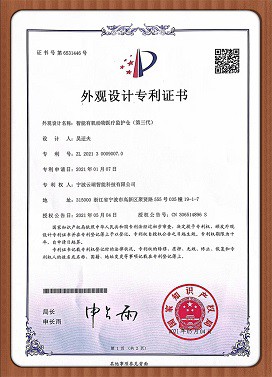

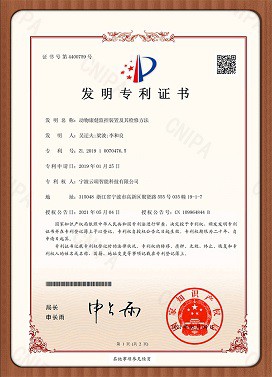
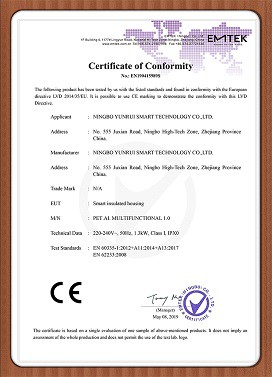
FAQ
Q: Can I feed my pet certain foods to help maintain their oral health?
Q: What are some common dental problems in pets?
Q: How are dental problems in pets diagnosed?
Q: Can dental problems in pets lead to other health problems?
Q: What are the treatment options for dental problems in pets?
Q: How much does a Veterinary Dental Cleaning cost?
Q: Is Veterinary Dental Cleaning covered by insurance?
Q: Can I schedule a Veterinary Dental Cleaning for my pet at the same time as their annual exam?
Q: What should I expect after my pet's Veterinary Dental Cleaning?
Q: Will my pet need to take any medications after a Veterinary Dental Cleaning?
Q: How can I prevent future dental problems in my pet?
Q: Why is Veterinary Dental Cleaning important?
Q: How often should my pet receive a Veterinary Dental Cleaning?
Q: What are the signs that my pet may need a Veterinary Dental Cleaning?
Q: What is included in a Veterinary Dental Cleaning?
Q: How is my pet sedated during a Veterinary Dental Cleaning?
Q: What type of toothbrush and toothpaste should I use for my pet?
Q: How long does a Veterinary Dental Cleaning take?
Q: Will my pet need any follow-up care after a Veterinary Dental Cleaning?
Q: Can I brush my pet's teeth at home to maintain their oral health?
As one of the leading veterinary dental cleaning manufacturers and suppliers in China, we warmly welcome you to wholesale or buy discount veterinary dental cleaning for sale here from our factory. All customized medical equipment are with high quality and competitive price.
dog teeth cleaning month, dog teeth cleaning vets, cat teeth cleaning vet

